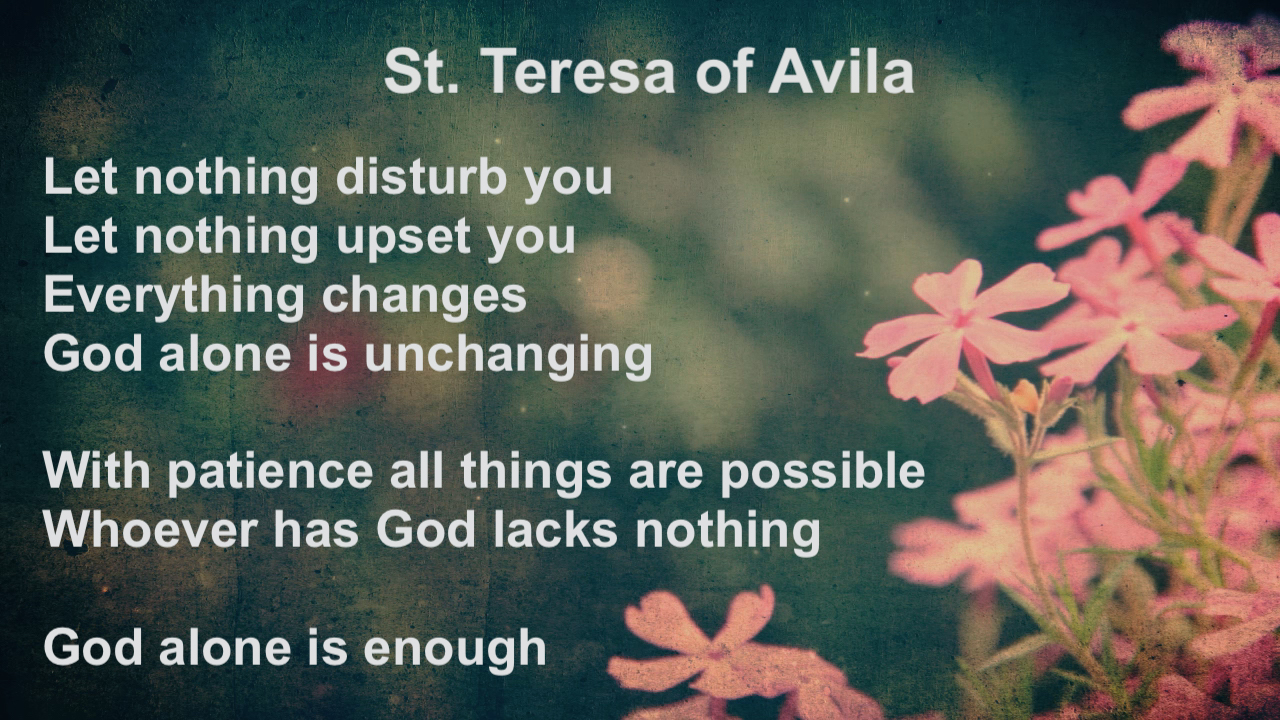Teresa's Bookmark

Yesterday, Richard Rohr shared the above prayer from Teresa of Avila as part of his blog post. This week, we will reflect on prayer after Easter.
I find it interesting that Jesus taught his disciples how to pray in Matthew 6:7-15. Don’t you find that interesting? Yes, of course, Jesus was a religious teacher who shared teachings that caused all of his hearers to reevaluate what they thought they knew about God. Some were willing to listen, others rejected his teaching outright, and still even others wanted to kill him for what he said. And there is enough material there to last us all a lifetime. Jesus’ teaching continue to illuminate the mystery of God’s being and God’s identity to us even 2,000 years later.
But Jesus also taught his disciples how to pray. In fact, at this point, he is standing on the side of a mountain, and there are large crowds who have followed him to hear this message he is about to give. Perhaps several thousand people are all gathered with him, and he begins to teach them to pray.
This may not sound all that odd to you, especially if you yourself grew up in or around religious communities. Prayer is a vital part of the existence of a religious group, so it doesn’t seem odd at all to teach followers of a religious teacher about and how to pray. In fact, many of us likely feel like we would like to have some instruction in the area of prayer. So, why do I find this so interesting?
To answer, I would like to remind us of the story of God’s people, Israel.
Israel, in Hebrew, means to “struggle with God” or to “wrestle with God” (not a bad description of prayer, in my opinion). It is also the name that God gives to Jacob in Genesis 32:28 after Jacob wrestles with a stranger all night before meeting his brother for the first time since he stole their father’s blessing from his older twin brother. It comes to be the identifier of the people that God had selected to work his purposes in the world through–the people that God promised to Abraham would be as countless as the sand on the seashore or the stars in the night sky. And so, generation after generation passes, and this people, this family, continues to grow larger and larger. Finally, they become a people. More than just a family, although they certainly are that too. And eventually, they become a nation too.
All of this is played out in the pages of the Old Testament. Their long and complicated history is recorded from Genesis through Deuteronomy in the Pentateuch, Joshua through the books of Kings and Chronicles, Ezra and Nehemiah, and even in the prophetic books we see snippets of history that we can piece together. But these books do not just contain the history of this family that grows into a nation. It specifically contains the history of this family that grows into a nation and their relationship with God.
This cannot be missed. Because their relationship with God is what makes this group of people different from all the rest. (The author Thomas Cahill makes the case, in fact, that this group of people and their relationship with God changes the rest of human history, specifically because they introduce to us a different conception that God and humanity can have genuine relationship, not simply coexist.) Their relationship with God is what defines them. The way they interact with God sets them apart and makes them holy. In view of all the rest of the world, this group of people, Israel, claims to have a unique understanding and relationship with God that can be seen through the pages of their history, their worship, and, of course, in their prayers. In the words that are shared back and forth between God and God’s people.
And it is to this group of people that Jesus, in the midst of his most important sermon that we have recorded in Scripture, begins to teach this people how to pray.
Of course, Jesus does not come to them as an outsider, but as an insider. He is one of them. Their history is his history. He is one of them. And yet, he teaches them to pray. He teaches them what we today call the Lord’s Prayer and why this kind of prayer is pleasing to God and useful to his people.
And it is a simple prayer. It is a prayer that acknowledges God’s sovereignty and holiness; a prayer that reminds us that God’s working in this world and bringing about the future that God intends; a prayer that relies upon God for all that we need, whether physical or spiritual.
In other words, it’s a prayer that is a lot like the prayer that St. Teresa prayed herself and that is found in the image above. Now, I don’t place these prayers in front of you in order to determine which one is better. Competition is not the purpose of spirituality. Both of these prayers are beautiful, simple, and honoring to God.
I place these prayers before you today and this week because I hope they remind us of just what we need to know about God this week. In the midst of all that you find yourself in the middle of today, remember that God alone is enough. Remember that God provides for us daily, and that we can rely on God to deliver us from temptations and difficulties.
Jesus taught his disciples and the crowds to pray then, even though they were the people of God who had a unique identity and calling. They understood things about God that their global neighbors didn’t and couldn’t in many cases. But Jesus taught them nonetheless. Today, allow Jesus to teach you how to pray. Even though you might have prayed all your life, and even if you are far from a beginner.
It is in prayer that we encounter this God today. May we all be people of prayer this week. May we continue to celebrate the resurrected Lord by praying, “God alone is enough.”

